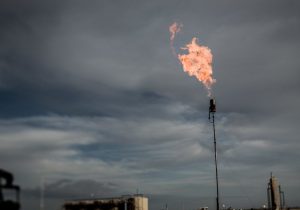S&P Global Analysis Says Industry’s Wasted Gas Could Bring Quick Relief to Energy Market
 Russia’s war on Ukraine has sent painful shockwaves through global gas markets — not only in Europe but across Asia and in developing economies that can least afford it. The crisis is accelerating efforts to transition to cleaner, safer, more reliable energy, while setting off a scramble for new gas supplies to backfill what once came from Russia. How to meet that near-term need without a massive new infrastructure buildout that would undermine climate goals and risk stranding billions in capital? One key solution – identified by EDF, the International Energy Agency and others — lies in the vast amounts of gas currently wasted by the oil and gas industry through flaring, leaks and other emissions.
Russia’s war on Ukraine has sent painful shockwaves through global gas markets — not only in Europe but across Asia and in developing economies that can least afford it. The crisis is accelerating efforts to transition to cleaner, safer, more reliable energy, while setting off a scramble for new gas supplies to backfill what once came from Russia. How to meet that near-term need without a massive new infrastructure buildout that would undermine climate goals and risk stranding billions in capital? One key solution – identified by EDF, the International Energy Agency and others — lies in the vast amounts of gas currently wasted by the oil and gas industry through flaring, leaks and other emissions.
New analysis published today by S&P Global estimates that by reducing these preventable losses in six key export regions, more than 80 billion cubic meters, or bcm, of methane could be captured and profitably brought to market. That’s almost 60 percent of Europe’s pre-war annual imports from Russia.
S&P Global Analysis Says Industry’s Wasted Gas Could Bring Quick Relief to Energy Market Share on XThe report lays out specific steps that could bring 40 bcm of gas to market in just two to three years, using export capacity either already in place or under construction today — averting 760 metric tonnes of CO2 equivalent at the exact time when companies and countries are trying to meet urgent new methane emission goals.
Before the war in Ukraine, Europe imported about 150 billion cubic meters of natural per year via pipeline from Russia — roughly 40 percent of its supply. Since then, Russian exports to Europe have been reduced by about three-quarters, while LNG imports from other parts of the world are up by about 50 bcm — driving energy price spikes that are hurting households and businesses around the globe.
Unlocking the Opportunity
S&P isn’t the first to cite methane capture as a win-win solution for both energy security and climate security. But their analysis — commissioned by EDF — is the first to identify how much captured methane could be brought to market quickly and profitably, where it could come from, and what barriers would need to be addressed to make it happen.
At today’s elevated prices, gas capture revenues would be ~140-240 percent higher over the next ten years than they would have been at pre-war prices. And projects executed next year would be 50 percent more profitable than those delivered in 2026, highlighting not only the urgency but the opportunity awaiting those who act quickly.
It’s one thing to spot an opportunity; it’s another to unlock it. The S&P analysis identifies key hurdles that need to be overcome, including capital availability for nationally owned oil companies in the global south; lease terms and national policies that distort pricing and revenues; and the need for gathering pipelines to bring captured gas to export facilities. Unlike massive LNG facilities, gathering systems can generally be amortized quickly, minimizing the stranded asset and carbon lock-in risk.
Policy Prospects
We at EDF believe there’s also a need for policy requiring robust leak detection and repair practices, the use of low-emitting equipment and strict prohibitions on venting and routine flaring. To get captured gas to market, countries may also need measures that give captured gas priority access to midstream and export infrastructure and to ensure that producers make productive use of associated gas from their oil wells, rather than simply flaring it off.
New methane rules under discussion in the U.S., Europe and Canada represent important steps on policy. Those packages need to be strengthened before being finalized.
Meanwhile, other major importers like China, Europe, Japan and South Korea — collectively representing 70 percent of globally traded gas — must embrace responsibility for upstream methane emissions embedded in the gas they buy. They should work with supplier nations to include methane intensity targets, mitigation project finance and the transfer of technical expertise as core elements of their supply agreements.
The Joint Declaration from Energy Importers and Exporters announced at last month’s climate talks could be a platform for these sorts of regional partnerships, but making it work requires broader participation from buyers in the European and Asia-Pacific markets, along with a seriousness of purpose equal to the challenge.
Likewise, the big “supermajor” oil companies have almost all made significant commitments around methane performance. They should extend those commitments to their extensive networks of joint ventures and bring their technical capacity and capital, to bear the facilitation and financing of methane mitigation projects with their partners in the global south.
Win-Win Solution
The energy crisis has revealed the fragility of a global system over-reliant on volatile fossil energy — not only driving dangerous climate change, but also making both rich and poor economies vulnerable to the whims of despots. Ultimately, energy security, economic security and climate security can only go hand in hand.
Cutting emissions of a potent climate pollutant to meet urgent, near-term need without locking in future dependence is an opportunity we shouldn’t miss.










